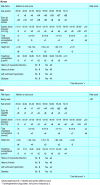A score for predicting risk of death from cardiovascular disease in adults with raised blood pressure, based on individual patient data from randomised controlled trials
- PMID: 11451781
- PMCID: PMC34541
- DOI: 10.1136/bmj.323.7304.75
A score for predicting risk of death from cardiovascular disease in adults with raised blood pressure, based on individual patient data from randomised controlled trials
Abstract
Objective: To create a risk score for death from cardiovascular disease that can be easily used.
Design: Data from eight randomised controlled trials of antihypertensive treatment.
Setting: Europe and North America.
Participants: 47 088 men and women from trials that had differing age ranges and differing eligibility criteria for blood pressure. MAIN OTUCOME MEASURE: 1639 deaths from cardiovascular causes during a mean 5.2 years of follow up.
Results: Baseline factors were related to risk of death from cardiovascular disease using a multivariate Cox model, adjusting for trial and treatment group (active versus control). A risk score was developed from 11 factors: age, sex, systolic blood pressure, serum total cholesterol concentration, height, serum creatinine concentration, cigarette smoking, diabetes, left ventricular hypertrophy, history of stroke, and history of myocardial infarction. The risk score is an integer, with points added for each factor according to its association with risk. Smoking contributed more in women and in younger age groups. In women total cholesterol concentration mattered less than in men, whereas diabetes had more of an effect. Antihypertensive treatment reduced the score. The five year risk of death from cardiovascular disease for scores of 10, 20, 30, 40, 50, and 60 was 0.1%, 0.3%, 0.8%, 2.3%, 6.1%, and 15.6%, respectively. Age and sex distributions of the score from the two UK trials enabled individual risk assessment to be age and sex specific. Risk prediction models are also presented for fatal coronary heart disease, fatal stroke, and all cause mortality.
Conclusion: The risk score is an objective aid to assessing an individual's risk of cardiovascular disease, including stroke and coronary heart disease. It is useful for physicians when determining an individual's need for antihypertensive treatment and other management strategies for cardiovascular risk.
Figures



Comment in
-
Predicting risk of death from cardiovascular disease. Outcome prediction is hampered by methodological problems.BMJ. 2001 Oct 27;323(7319):1000. BMJ. 2001. PMID: 11700623 No abstract available.
-
Predicting risk of death from cardiovascular disease. Individual cardiovascular risk cannot be predicted.BMJ. 2001 Oct 27;323(7319):1000. BMJ. 2001. PMID: 11700624 No abstract available.
References
-
- Anderson KM, Odell PM, Wilson PW, Kannel WB. Cardiovascular disease risk profiles. Am Heart J. 1991;121:293–298. - PubMed
-
- D'Agostino RB, Russell MW, Huse DM, Ellison RC, Silbershatz H, Wilson PWF, et al. Primary and subsequent coronary risk appraisal: new results from the Framingham Study. Am Heart J. 2000;139:272–281. - PubMed
-
- Menotti A, Keys A, Blackburn H, Kromhout D, Karvonen M, Nissinen A. Comparison of multivariate predictive power of major risk factors for coronary heart diseases in different countries: results from eight nations of the seven countries study, 25 years of follow-up. J Cardiovascular Risk. 1995;3:69–75. - PubMed
-
- Pooling Project Research Group. Relationship of blood pressure, serum cholesterol, smoking habit, relative weight and ECG abnormalities to incidence of major coronary events: final report of the pooling project. J Chronic Dis. 1978;31:201–306. - PubMed
Publication types
MeSH terms
Substances
LinkOut - more resources
Full Text Sources
Other Literature Sources
Medical
